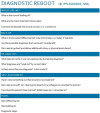Diagnostic Reboot: A Proposal to Improve Diagnostic Reasoning
- PMID: 33614306
- PMCID: PMC7883530
- DOI: 10.7759/cureus.12698
Diagnostic Reboot: A Proposal to Improve Diagnostic Reasoning
Abstract
Background Diagnostic errors contribute to the morbidity and mortality of patients. We created and utilized a novel diagnostic tool (Diagnostic Reboot) and assessed its practical efficacy in the inpatient setting for improving diagnostic outcomes. Design This was a prospective sequential controlled study that involved University Hospitalist Adult Teaching Service (UHATS) teams. Senior residents were instructed to use the Diagnostic Reboot (DxR) tool whenever a patient aged 19-99 years was identified who had an uncertain diagnosis 24 hours into their admission. Results Participating residents identified a total of 32 patients as meeting the criteria of uncertain diagnosis after at least 24 hours of hospitalization during the six months of the study period. Of these, seven were during the intervention (DxR) period. The leading diagnosis was excluded in 3/7 (43%) patients in the DxR period and 13/25 (52%) in the control period. A new leading diagnosis was made in 6/7 (86%) cases in the DxR period and in 13/25 (52%) people in the control period. A new diagnostic plan was made in 100% of the patients in the DxR group and in 80% of patients in the control group. A new consultation was requested in 4/7 (57%) patients in the DxR group and in 9/25 (36%) patients in the control group. The Residents spent an average of 20 minutes on the DxR tool. Conclusions This study demonstrated that the use of DxR may help to improve analytical thinking in residents. It may also play a role in improving outcomes in medically challenging cases, but the use of the tool during the study period was not sufficient to draw concrete conclusions. The primary barrier to the use of such a diagnostic aid was identified as time pressure on a busy hospitalist service.
Keywords: diagnosis; missed diagnosis; physical exam; reboot.
Copyright © 2021, Walayat et al.
Conflict of interest statement
The authors have declared that no competing interests exist.
Figures



Similar articles
-
Digital radiogrammetry as a new diagnostic tool for estimation of disease-related osteoporosis in rheumatoid arthritis compared with pQCT.Rheumatol Int. 2005 Aug;25(6):457-64. doi: 10.1007/s00296-004-0560-z. Epub 2005 Mar 11. Rheumatol Int. 2005. PMID: 15761729
-
Systematic reviews of the effectiveness of day care for people with severe mental disorders: (1) acute day hospital versus admission; (2) vocational rehabilitation; (3) day hospital versus outpatient care.Health Technol Assess. 2001;5(21):1-75. doi: 10.3310/hta5210. Health Technol Assess. 2001. PMID: 11532238 Review.
-
Comparison of Resident, Advanced Practice Clinician, and Hospitalist Teams in an Academic Medical Center: Association With Clinical Outcomes and Resource Utilization.J Hosp Med. 2020 Dec;15(12):709-715. doi: 10.12788/jhm.3475. J Hosp Med. 2020. PMID: 33231541
-
[Clinical trial for differentiation between corticoid-induced osteoporosis and periarticular demineralization via digital radiogrammetry in patients suffering from rheumatoid arthritis].Z Rheumatol. 2004 Dec;63(6):473-82. doi: 10.1007/s00393-004-0632-1. Z Rheumatol. 2004. PMID: 15605213 German.
-
The value of a hospitalist service: efficient care for the aging population?Chest. 2001 Feb;119(2):580-9. doi: 10.1378/chest.119.2.580. Chest. 2001. PMID: 11171741
Cited by
-
Effect on diagnostic accuracy of cognitive reasoning tools for the workplace setting: systematic review and meta-analysis.BMJ Qual Saf. 2022 Dec;31(12):899-910. doi: 10.1136/bmjqs-2022-014865. Epub 2022 Sep 2. BMJ Qual Saf. 2022. PMID: 36396150 Free PMC article.
References
-
- National Academies of Sciences, Engineering Engineering, and Medicine. The National Academies of Sciences, Engineering, and Medicine. Washington, DC: National Academies Press; 2015. Improving Diagnosis in Health Care.
-
- Special emphasis notice (SEN): AHRQ announces interest in research on diagnostic errors in ambulatory care settings. [Jan;2021 ];https://grants.nih.gov/grants/guide/notice-files/not-hs-08-002.html 2007
-
- Medical error—the third leading cause of death in the US. Makary MA, Daniel M. BMJ. 2016;353:0. - PubMed
-
- Gawande A. Vol. 978. New York: Metropolitan Books; 2009. The Checklist Manifesto: How To Get Things Right; pp. 0–80.
LinkOut - more resources
Full Text Sources
Other Literature Sources
